|
[ Back ] [ Home ] [ Up ] [ Next ]
[ Merida
and the Andes Mountains write-up
]
 |
|
(same map as on
page 12)
VENEZUELA INLAND
TRAVEL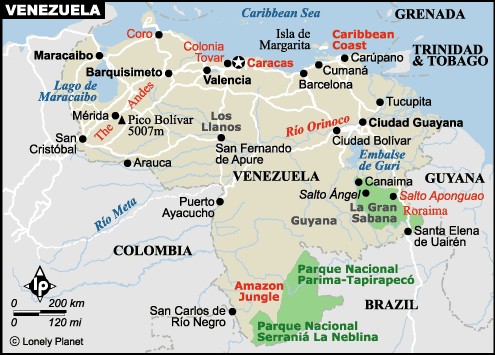 - cont'd. - cont'd.
Puerto La Cruz /
Barcelona
located on North coast. This
is where we are with ARGO.
Los Altos
is just to the east.
Angel Falls (Salto Angel) / Canaima
located in Southeast Venezuela.
Merida / The Andes / Los Nevados located
in Northwest Venezuela.
Colonia
Tovar located west of
Caracas.
Caracas
located on north coast.
|
|
MERIDA and the ANDES
MOUNTAINS, and Colonia Tovar,
Caracas
In summary, we
traveled inland to the western part
of Venezuela into the Andes Mountains
where we stayed in Merida,
traveled by mules to a remote town in the
mountains (this is the real thing).
We explored other nearby areas, then
returned through the authentic German
village of Colonia Tovar, and on to
Caracas for a few nights. All
intercity travel was by bus - some
luxury and some not. |
|
MERIDA
We took a nice big
bus from Puerto La Cruz for a
24-hour trip (usually 18 hours but
recent mudslides wiped out bridges,
tunnels and roads requiring us to
make 2 major detours) to Merida.
These long-distance buses are called
buscama, meaning "bus bed",
as the seats recline substantially
with foot rests,
and they show movies (usually in
English), and they are always kept
cold like a meat locker so we wore
long clothes and had jackets, gloves
and a blanket. The detour into Merida
was a nail-biter as the bus hugged
the mountain on one side, road
crumbling down a sheer cliff on the
other. As it turned out, this
was only a warm-up for several of
our other adventures.
In Merida we
stayed with
well-known-among-the-cruising-community
 Gioia
(pictured at right),
a young Italian Venezuelan who rents
out rooms in her centrally located
3-story, 3-atrium "townhouse", but only to
English-speaking cruisers (in 10
years she has never had a problem).
She gave us an orientation of the
city and area, a set of keys and we
were off exploring. Gioia
(pictured at right),
a young Italian Venezuelan who rents
out rooms in her centrally located
3-story, 3-atrium "townhouse", but only to
English-speaking cruisers (in 10
years she has never had a problem).
She gave us an orientation of the
city and area, a set of keys and we
were off exploring.
Merida is perched
half-way down a mountain on a large
protruding mesa, or
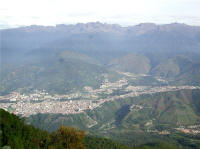 plateau,
in the middle of the Andes
Mountains at an elevation of 5, 200
ft.. As the mesa is long
and narrow, the city has been forced
to grow to the west and east,
creating a sprawling metropolitan
area. Merida is a very clean,
safe and bustling
college town and much larger than
expected - 275,000 inhabitants of
which 40,000 are students at the
University of Los Andes (ULA).
Tuition is FREE to ULA, and also the
University in Caracas, and cost of
room and board is literally a couple
of dollars (US$6) a semester! No
wonder there are so many
"professional" students here! This includes their medical and
dental schools, and Gioia's daughter
had just finished law school - which
cost about US$16/semester (not a
typo).
This place has the feel of Austin
(before the boom) and Boulder but
with a Venezuelan flavor. Merida is also a safe place and
Guardia Nacional, police and other
security are prominent all over. plateau,
in the middle of the Andes
Mountains at an elevation of 5, 200
ft.. As the mesa is long
and narrow, the city has been forced
to grow to the west and east,
creating a sprawling metropolitan
area. Merida is a very clean,
safe and bustling
college town and much larger than
expected - 275,000 inhabitants of
which 40,000 are students at the
University of Los Andes (ULA).
Tuition is FREE to ULA, and also the
University in Caracas, and cost of
room and board is literally a couple
of dollars (US$6) a semester! No
wonder there are so many
"professional" students here! This includes their medical and
dental schools, and Gioia's daughter
had just finished law school - which
cost about US$16/semester (not a
typo).
This place has the feel of Austin
(before the boom) and Boulder but
with a Venezuelan flavor. Merida is also a safe place and
Guardia Nacional, police and other
security are prominent all over.
We got to know our
way around Merida pretty well:
Bolivar Plaza with street vendors
and artists, various parks, museums,
the large food and dry goods market,
checked out some really good
restaurants, etc.
|
MERIDA
Heladeria Coromoto:
1000 flavors of ice cream, appears
in the Guiness Book of Records
 
Dreadful sounding
ice cream, shown here L to R: Tuna,
Cream of Crab, Squid and Smoked
Trout. Not shown, Onion, Hot
Dog, Garlic, Taco . . .
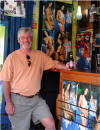
Favorite
street bar with Polar Chica posters
(Polar is the Venezuelan Beer)
|
|
LOS NEVADOS
We then take off
for an adventurous trip into a
remote area of the Andes (Sierra
Nevada National Park), a little
village called Los Nevados.
Having left a lot of our stuff at
Gioia's, we pack essentials
including cold weather clothes into
2 backpacks and head up the mountain
on the Teleferico. The
Teleferico is an aerial tram, the longest serial
(7.8 miles, 4 stations, the last of
which has been closed for repairs) and highest
(15,600 ft.) in the world. This
ride affords a
wonderful view of Merida lying on
the mesa. At the 3rd station,
13,200 ft., we find the only guide
available and his one mule and one
burro and head up, over, down and
around the mountains for a 4-hour
ride. Let me tell you, this is
the real thing!
 A mule is like a
smallish horse. On the other
hand, a burro (which
we had been cautioned NOT
to ride) is much smaller, lower to
the ground, NOT as surefooted (an
attribute you definitely want in the
mountains) and waddles along - there
were some striking similarities
between him and "Donkey" in the movie
"Shrek".
(Pictured L to R: squatty Burro,
seasoned Guide, surefooted Mule,
nervous Steve) A mule is like a
smallish horse. On the other
hand, a burro (which
we had been cautioned NOT
to ride) is much smaller, lower to
the ground, NOT as surefooted (an
attribute you definitely want in the
mountains) and waddles along - there
were some striking similarities
between him and "Donkey" in the movie
"Shrek".
(Pictured L to R: squatty Burro,
seasoned Guide, surefooted Mule,
nervous Steve)
Our trip initially consisted of
cussing, sore private parts and
other anatomy, and statements like
"what were you thinking!?".
Redirect: Uh-huh, Bob and
Susan (s/v Sunrise) what WERE you
thinking when you recommended this
trip to us??? Steve's willful
mule took gleeful pleasure in
walking right on the edge of
the crumbly sheer cliff.
Deborah's short and clumsy burro had
her fearful from the start, and for
good reason: Early on the
thing faltered and slipped down
causing Deborah to fall off - at
least she fell into the
mountain and not
 down
the mountain! After reaching down
the mountain! After reaching
 our
first of many
summits (what goes up must come
down), yep,
there is was, a very steep downhill
stretch of
loose rocky
terrain (pictured at left). At
this point we both opted to hike
this section (pictured at right),
which was still treacherous, and
sent the guide ahead with our
transportation. Along came
another guide with 2 unoccupied
mules and Deborah in her now-better
Spanish begged for his mule, so we
ended up with 2 guides, 2 mules and
the burro now carried our backpacks
scrambling ahead out of sight.
The rest of the journey was for the
most part better (not as steep and
treacherous) our
first of many
summits (what goes up must come
down), yep,
there is was, a very steep downhill
stretch of
loose rocky
terrain (pictured at left). At
this point we both opted to hike
this section (pictured at right),
which was still treacherous, and
sent the guide ahead with our
transportation. Along came
another guide with 2 unoccupied
mules and Deborah in her now-better
Spanish begged for his mule, so we
ended up with 2 guides, 2 mules and
the burro now carried our backpacks
scrambling ahead out of sight.
The rest of the journey was for the
most part better (not as steep and
treacherous)
 and
we were able to enjoy the
spectacular panoramic views down
between the mountains ranges.
(In picture, our mule trails visible
in background.)
Incredibly, we went across several
mountains, crossed the valley and
then up and around several more
mountains. Total trip traveled
was supposedly close to 9 miles.
Sure felt further. We dressed
for cold weather and were
pleased with blue skies and warmish
daytime temperatures. Incidentally, the
guides and mules stay at Los Nevados
and are brought over to the
Teleferico early in the morning.
The guides usually walk - this means
a guide walks for 8-10 hours a day
across these mountains! and
we were able to enjoy the
spectacular panoramic views down
between the mountains ranges.
(In picture, our mule trails visible
in background.)
Incredibly, we went across several
mountains, crossed the valley and
then up and around several more
mountains. Total trip traveled
was supposedly close to 9 miles.
Sure felt further. We dressed
for cold weather and were
pleased with blue skies and warmish
daytime temperatures. Incidentally, the
guides and mules stay at Los Nevados
and are brought over to the
Teleferico early in the morning.
The guides usually walk - this means
a guide walks for 8-10 hours a day
across these mountains!
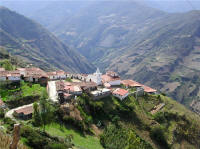 We round another
mountain bend and behold Los Nevados
hanging on the mountain
side, extending out onto a small
mesa, with a breathtaking view down
the valley. We ride into this
genuine little village and down
their We round another
mountain bend and behold Los Nevados
hanging on the mountain
side, extending out onto a small
mesa, with a breathtaking view down
the valley. We ride into this
genuine little village and down
their
 only
street, along with the other mules,
burros, horses and
cattle being herded at day's end.
Some people want us to look at their posadas, which we politely did, and
then bee-lined it to the only
recommended posada at the end of the
street/town. The Bella Vista Posada
is situated on the edge of the mesa
with a wonderful view from our
shower (hot
water!) and from our rustic but nice
room. (In the above/left
picture, our only
street, along with the other mules,
burros, horses and
cattle being herded at day's end.
Some people want us to look at their posadas, which we politely did, and
then bee-lined it to the only
recommended posada at the end of the
street/town. The Bella Vista Posada
is situated on the edge of the mesa
with a wonderful view from our
shower (hot
water!) and from our rustic but nice
room. (In the above/left
picture, our
 room
is the building furthest to the
right.) No
heat in the rooms but a couple of
heavy plush
blankets to pile on at night.
As we have found out, power outages
are frequent in the mountains, so we
were prepared with flashlights and
candles.
Breakfast and dinner were included
(good thing as there appeared no
place else to eat). (Two
nights + 2 meals/day cost us a total
$40.) room
is the building furthest to the
right.) No
heat in the rooms but a couple of
heavy plush
blankets to pile on at night.
As we have found out, power outages
are frequent in the mountains, so we
were prepared with flashlights and
candles.
Breakfast and dinner were included
(good thing as there appeared no
place else to eat). (Two
nights + 2 meals/day cost us a total
$40.)
With the
awesome vistas and perfect weather,
we instantly forgot all the pains of
getting here, kind of like child
birth, I guess. We decide to
spend 2 nights. Not much to do
but enjoy the mountain view from
several outdoor sitting areas, hike
around a little, snooze in the
hammocks, read and relax. The
only way out of here is by a
treacherous, deeply rutted little
road traveled only by a few
Los Nevados locals in their 4x4
jeeps. It's a bouncy 4-hour
ride, and when you can manage to
take your eyes off the precipitous
view downward (tires on the edge
just like the mules), the views are
dramatic. OK, we're down to
cuticles, now. But more to
come later.
In spite of all
we endured (it really wasn't that
bad, just ask s/v Sunrise), we
recommend this trip to anybody
adventuresome. Some people
hike this in 5 - 6 hours. The
rewards far out-weigh the
uncomfortable.
|
Town or
Village? The
difference is that "towns" have
a Plaza Bolivar, or town square,
with a church facing onto the
plaza, and a statue of Simon
Bolivar, "the liberatador".
The bigger the statue of Simon,
the bigger the dot on the map.
Now we know how Caracas got so
big - it has a full-body
statue of Simon Bolivar on
his horse with it's 2 legs
raised up!
Merida (right) rates close with
1 leg up. statue of Simon,
the bigger the dot on the map.
Now we know how Caracas got so
big - it has a full-body
statue of Simon Bolivar on
his horse with it's 2 legs
raised up!
Merida (right) rates close with
1 leg up. |
|

At the top of
the Teleferico we get some last
minute nutrition: Strawberries &
cream & cream - very popular in the
Andes, as they grow strawberries
high up
LOS NEVADOS

Making bricks by
hand


View down "the"
street


"Port hole" view from our shower |
|

Oxen plowing field of
carrots

Condors: They have
a wingspan of 9 ft. and can soar at
30,000 ft.. In
Venezuela: 2 injured ones in
captivity (above), 3 in zoo and 5 in
the wild.
 |
DAY TRIPS to the
NORTHWEST and NORTHEAST of Merida
We did a day trip
on a
 local bus to
Jaji (pictures left and
right) in the mountains to the
northwest and local bus to
Jaji (pictures left and
right) in the mountains to the
northwest and
 walked to a coffee
plantation. Another day we did
a road trip with Gioia to see the condors and
northeast area. All afforded
grand panoramic views and many
villages perched on mesas suspended
in the great valleys. walked to a coffee
plantation. Another day we did
a road trip with Gioia to see the condors and
northeast area. All afforded
grand panoramic views and many
villages perched on mesas suspended
in the great valleys.
So as
not to have to endure another
24-hour bus ride back to Puerto La
Cruz, we broke the trip up and did a
12-hour overnight bus ride to Maracay. Leaving Merida
on the detour road (tunnel damaged
in mudslide) in the dark was another
nail-biter, as men were lining the
road to help coordinate one-way
traffic.
In Venezuela,
there are checkpoint stations you
stop at whenever you cross over into
another state (in all we were in 8
states) and the Guardia Nacional has
the option to search or whatever -
this is primarily for drugs,
Colombians, bad guys and another way
for someone to make a few bucks.
As the entire bus slept, we were
suddenly awaken by the Guardia
Nacional, demanding passports and
immigration clearance papers from
all foreigners. We had been
forewarned to take our individual
clearance papers (not something we
would normally carry), otherwise
they will hit you up for $$ saying
you are in the country illegally.
Friends got hit for $100, but
negotiated down to $60. A
fellow passenger was removed from
the bus with all his luggage and
returned 20 minutes later, not sure
how much lighter his wallet was.
Incidentally, we always carry
copies of our passport on our person
in Venezuela, and even when in the
dinghy it is required to have the
dinghy and outboard registrations
onboard (to prove ownership).
|

"Petting" the
Frailejon - like Lamb's Ear but much
plusher. They only grow in
Venezuela above 10,000 ft.

All-stone church
built by one man (buried there), in
San Rafael de Mucuchies |
|
COLONIA TOVAR
Anyway, 2 local
buses later we are dropped of in the
authentic German town of
Colonia
Tovar, way high up in the
mountains. All our training on
winding mountain roads still had us
nervous as the final local bus
driver loved zooming around the
curves. It was a very long way
straight down. Colonia Tovar
was
 developed in the 1840's when it
was clear the Venezolanos developed in the 1840's when it
was clear the Venezolanos
 did
not know how to properly farm land
and cultivate crops on the steep, but fertile
mountain slopes. So a couple
hundred German farmers and related workers came to colonize Colonia Tovar. Today Colonia
Tovar retains it's obvious German
influence but has also become a
tourist attraction. It is a
lovely town spread up and down on
winding streets, European in feel. did
not know how to properly farm land
and cultivate crops on the steep, but fertile
mountain slopes. So a couple
hundred German farmers and related workers came to colonize Colonia Tovar. Today Colonia
Tovar retains it's obvious German
influence but has also become a
tourist attraction. It is a
lovely town spread up and down on
winding streets, European in feel.
|
|
CARACAS
The next day we
caught a local bus and headed to
Caracas.
We were advised not to take the bus
all the way in to Caracas as it was
not safe. Instead, we got off
at a town (El Junquito) outside
Caracas, our friend negotiated a
taxi for us and we were off for a 1
1/2 hour taxi ride into the big
city.
We stayed 2 nights
at a little hotel recommended by
cruisers as being in a
 safe area
(i.e., safe to walk around including
nice park areas), conveniently
located to the subway and reasonably
priced. (Picture is from our
room at sunset.) Everybody has heard of
Caracas and how dangerous it is, so
we took additional precautions:
Wore no jewelry including watches,
carry absolutely nothing (no
camera), stowed minimal cash in
several deep pockets and kept very
aware of our surroundings. We
had at least 4 guardian angels
watching over the American gringos:
"Don't go down that street, go
back", "leave the zoo by 3:00",
"Don't get off the subway until xxxx",
"You need to be very careful here"
and we had one man walk us to
transfer subways. So now we
can sport "I survived Caracas"
t-shirts. Interestingly
enough, we saw lots of security
personal in Merida and Colonia Tovar
(guess that's why they're so safe),
but in Caracas we saw only a
handful! safe area
(i.e., safe to walk around including
nice park areas), conveniently
located to the subway and reasonably
priced. (Picture is from our
room at sunset.) Everybody has heard of
Caracas and how dangerous it is, so
we took additional precautions:
Wore no jewelry including watches,
carry absolutely nothing (no
camera), stowed minimal cash in
several deep pockets and kept very
aware of our surroundings. We
had at least 4 guardian angels
watching over the American gringos:
"Don't go down that street, go
back", "leave the zoo by 3:00",
"Don't get off the subway until xxxx",
"You need to be very careful here"
and we had one man walk us to
transfer subways. So now we
can sport "I survived Caracas"
t-shirts. Interestingly
enough, we saw lots of security
personal in Merida and Colonia Tovar
(guess that's why they're so safe),
but in Caracas we saw only a
handful!
 In
our 2 days in Caracas we
visited several
museums (a couple pretty good), rode the
local Teleferico up for a great view
of huge Caracas, visited the zoo
(think we were ill-advised and
visited the wrong one as it was a
bust) and botanical gardens, walked
our neighborhood filled with
parks/sculpture garden, and many
restaurants, and last but not least
the huge 4-story Sambil Mall filled
with lots of nice shops and a
wonderful selection of quite nice
restaurants for outdoor rooftop
dining, movies, arcades and ice
skating rink. Similar to
Houston's Galleria. In
our 2 days in Caracas we
visited several
museums (a couple pretty good), rode the
local Teleferico up for a great view
of huge Caracas, visited the zoo
(think we were ill-advised and
visited the wrong one as it was a
bust) and botanical gardens, walked
our neighborhood filled with
parks/sculpture garden, and many
restaurants, and last but not least
the huge 4-story Sambil Mall filled
with lots of nice shops and a
wonderful selection of quite nice
restaurants for outdoor rooftop
dining, movies, arcades and ice
skating rink. Similar to
Houston's Galleria.
We take a luxury
buscama back to Puerto La
Cruz after our wonderful 2-week
trip.
|
If you're
interested in the particulars
about our trip, such as
accommodations, transportation
and costs, check out the
write-up we did for other
cruisers,
Merida
and the Andes Mountains write-up
including Colonia Tovar and
Caracas. There are more
pictures here, too. |
|
CARACAS
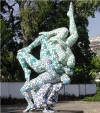
Cirque du Soleil???

|
|
We got quite an
earful about Chavez. Out of a
total population of 24 million
people, 4 million are Columbians.
We were told Chavez "opened" the
border, allowing Columbians to come
in - he needed their votes come
election time. Chavez also
deemed it necessary to rename the
country: from Republica de
Venezuela to Republica
Bolivariana de Venezuela.
This then required that all currency
be reissued (which is printed in
China, so who benefits???), and all
government paperwork be reprinted,
and all cedulas, which are
personal identification numbers
similar to our social security
numbers be reissued. While
we're on the subject, we are asked
for our passport number (our "cedula")
whenever transacting business,
including medical, banking and
shopping, even for a $1 purchase.
Big brother is watching!
|

Above: Aerial view shows large
marina area and picturesque canal
system (more below)
  |
PARTING SHOTS of PUERTO LA CRUZ
 Easter ("Semana
Santa") is celebrated big here.
On "Good Friday", we joined the
locals for their traditional
Catholic "Stations of the Cross".
This is a reenactment starting at a
church, and turns into a procession
down the main waterfront street.
It dramatically culminates at a big
hill with the three crucifixions and
tomb. Easter ("Semana
Santa") is celebrated big here.
On "Good Friday", we joined the
locals for their traditional
Catholic "Stations of the Cross".
This is a reenactment starting at a
church, and turns into a procession
down the main waterfront street.
It dramatically culminates at a big
hill with the three crucifixions and
tomb.
There are lots of boats here in
Puerto La Cruz from Texas, in
particular Houston: Sunrise,
Texas Reb, Precocious Gayle,
Lorelei, Starlight Dancer, Fun
Ticket, Discovery, Little Mermaid .
. .

And then there is the final
provisioning. Can you guess
what is being loaded on ARGO below?

HINT:
Steve with Polar eyes and Polar
Chicas . . .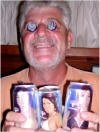
Our Venezuelan
travels continue on
page
14 . . .
|
BAHIA REDONDA MARINA  
Bottom: Spot for frequent Potluck
BBQs with a great view all around |
[ Back ] [ Home ] [ Up ] [ Next ]
[ Top of page ]
[ Merida
and the Andes Mountains write-up
]
|
![]()